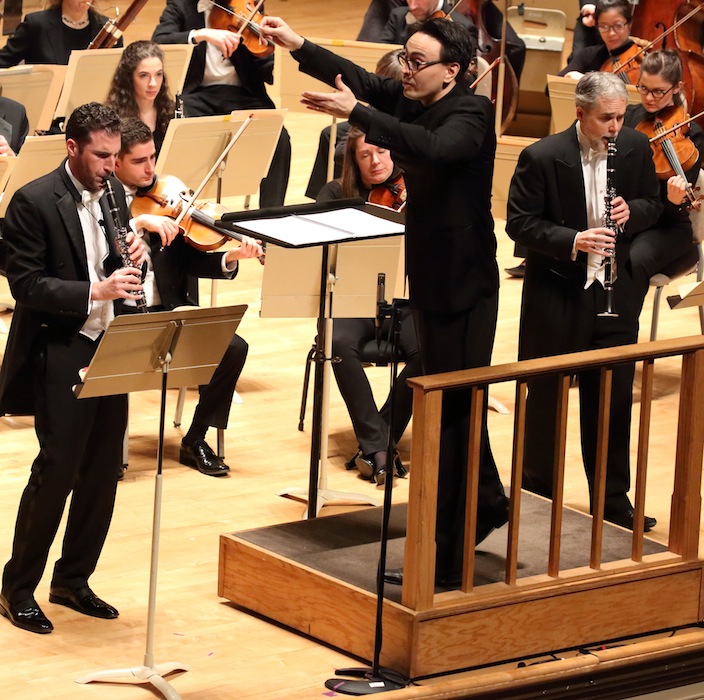BSO members step into the spotlight to open new year

Michael Wayne and William R. Hudgins perform Krommer’s Concerto No. 2 for two clarinets with Ken-David Masur and the BSO Thursday night. Photo: Hilary Scott
Every season of the Boston Symphony Orchestra spotlights a starry lineup of soloists. Yet these guests often overshadow the individual musicians of the BSO, some of whom are stellar soloists themselves.
Thursday night at Symphony Hall, soloists drawn from the orchestra’s ranks offered a wide-ranging program of concertos by Vivaldi, Schumann, Krommer, Jolivet, and Rota. Assistant conductor Ken-David Masur led the way.
Each work on the program brought its own degree of technical difficulty.
As with many of Vivaldi’s concertos, the Piccolo Concerto, RV 443 is a florid display of filigree that offers a chance for the soloist to show off. Piccoloist Cynthia Meyers did just that, though with a sense of understated drama. Her tone is clear and ripe, her technique fluent, and she threw off the trickling passages of the score with aplomb.
The second movement featured the piccolo in a svelte melody, which Meyers spun in long flowing arcs of sound. In support, Masur coaxed an accompaniment marked more by tender elegance than Baroque fire.
Schumann’s Concert Piece for Four Horns and Orchestra, Op. 86 is a concerto in all but name. Its three movements call for the hornists to perform brilliant fanfare figures as well as passages of song-like melody, parts of the work that recall the composer’s affinity for the vocal line.
The soloists—James Sommerville, Michael Winter, Rachel Childers, and Jason Snider—played with warm tone and, for the most part, cohesive musicality. Some of the fanfare figures weren’t always cleanly executed, and the ensemble suffered from an unfocused blend in the blazingly high passages of the piece, the netherworld for many a French hornist.
The second movement, a Romance, fared best. Here the quartet swelled their phrases for plush statements. In accompaniment, Masur drew golden strands of melody from the orchestra.
André Jolivet discounted the influence of Stravinsky, yet his Concertino for Trumpet, String Orchestra, and Piano reflects aspects of the latter composer’s style. Cast in a single movement, the work unfolds as a series of variations. Agitated statements for strings and piano abound. The trumpet part, with its wide leaps, moves in fits and starts, pausing at times on clarion high notes. Trumpeter Thomas Rolfs handled it all with gleaming tone and song-like expression.
The slow section was particularly haunting. Rolfs’ muted trumpet captured a nervous energy to recall the similar loneliness of Copland’s Quiet City. Pianist Vytas Baksys supplied the percussive passages with precision and strength.
Nino Rota’s Concerto for Trombone and Orchestra is similarly angular, yet there is warmth to the composer’s musical language. Rota is best known for his many film scores, and his concert and stage music, equally tuneful, show a fine technical and musical mind.
The second of the concerto’s three movements is more searching than lyrical. Its pointillistic melody featured trombonist Toby Oft in fine displays of precision. In the first movement, Oft brought a singing tone to the bare and winding lines. There were a few unfortunate cracks and fluffed notes in the third movement. But Oft found the robust energy of the movement’s attractive melodic phrases.
Lyricism of another kind marked Franz Krommer’s Concerto No. 2 for Two Clarinets and Orchestra, Op. 91, which clarinetists William R. Hudgins and Michael Wayne performedThursday night.
Little is written or remembered about Krommer today, but he was highly regarded in his own time. Younger than Mozart, the Moravian composer built a successful career in Vienna and wrote pieces that mixed charming melodies with Haydnesque wit.
His Op. 91 is one such work. Its three movements flow with an operatic lyricism. The two clarinets trade burbling phrases that could match the buoyancy of any coloratura aria. Hudgins and Wayne played with a fine ear to the musical line, shaping their phrases with gentle dynamic shading. Likewise, Masur kept a fine eye to the details of the score, coaxing florid countermelodies to match the soloists’ efforts.
The most beautiful playing came in the second movement. There, the soloists shared a soft sense of the vocal-like lines, each musician layering warm blankets of sound upon the other. The result was a marvel of musical partnership and a fine example of orchestral musicians as soloists.
The program will be repeated 1:30 p.m. Friday and 8 p.m. Saturday at Symphony Hall.bso.org; 888-266-1200
Posted in Performances





Posted Jan 07, 2017 at 11:43 am by Laura Barron
I attended the January 6th afternoon performance and enjoyed it immensely. This is a fair review. It was a great opportunity to see the BSO Wind musicians strut their stuff and hear music infrequently played by a symphony orchestra. A definite must see event!